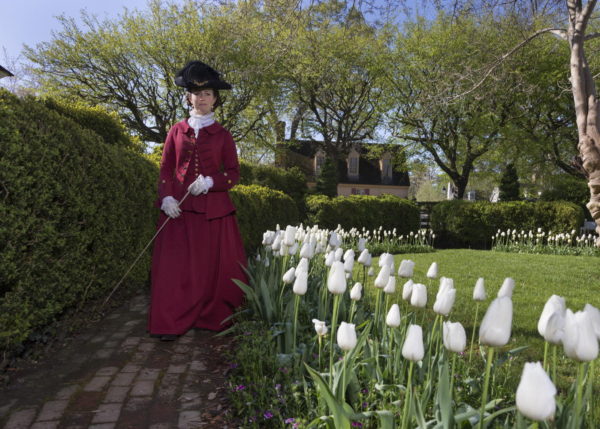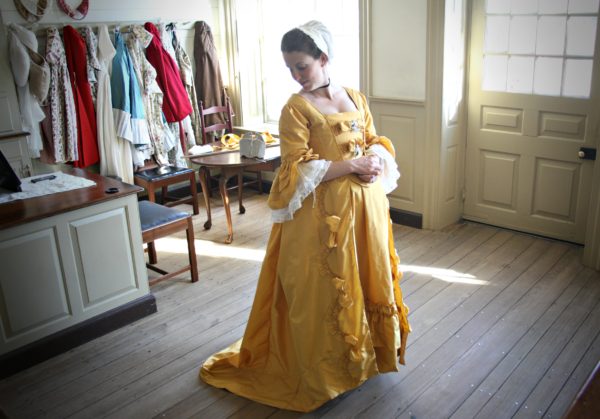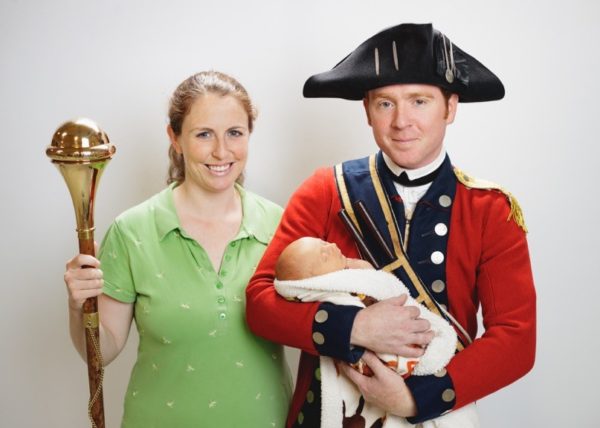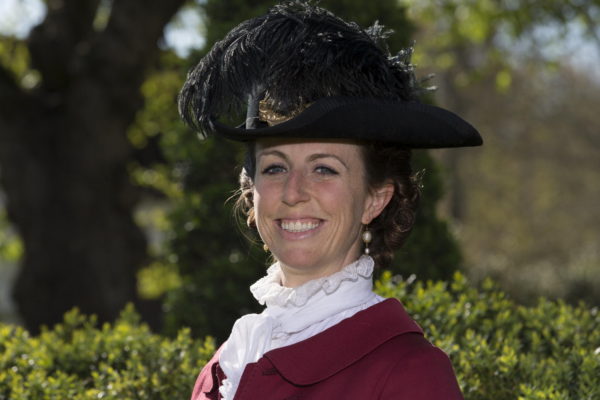
Before she was Mrs. Washington, Martha was Mrs. Custis. It’s well known that Martha and George Washington were not blessed with any children of their own during their 40-year marriage (theories abound…we’ll get to that another time). Martha did have four children, though, during her first marriage to Daniel Parke Custis.
This period of Martha’s life has fascinated me and has become the center of my study and program development for the spring season. I suppose I have good reason: my husband and I just welcomed our first child.
I’ve been thinking a lot about what has changed, and what hasn’t, regarding childbirth. What must it have been like for Martha as she prepared for this life passage?

Martha married Daniel Parke Custis on May 15, 1750 and was pregnant with their first child by 1751. She would give birth to a son, named Daniel after his father, in 1751. Little is known about young Daniel and Frances, her second child, as they died very young, at ages four and two, respectively. Infant death was not abnormal, but it was still tragic.
In comparing Martha’s passage from wife to mother to my own experience, I have noticed some striking similarities. For example, mint or ginger tea was often prescribed for morning sickness, something my own doctors and mom friends advised me to drink as well.
There are also some vast differences. For instance, in Martha’s day it was the tradition, or social ritual, for only women to attend the birth; nowadays it’s expected for the father to be there, and oftentimes there is an audience of both male and female doctors and nurses while you are delivering your child.

Today a baby doesn’t leave the hospital without a name on the birth certificate. But in the 18th century it was not uncommon to wait to name a child until you were sure they would survive those precarious first months, instead referring to them as the “Little Stranger” until such a time, and name, seemed appropriate. While losing a child is still tragic today, thanks to medical advances it is less and less common than in Martha’s time.
When I first found out I was pregnant I was determined to not let anyone treat me any differently. Of course, that was a fleeting hope, as people immediately began to look at my stomach before my face and treating me like I was a ticking time bomb. In our modern world, a pregnant lady is often someone who should be pampered, taken care of, and given copious amounts of ice cream (that last one I am OK with).

I was instructed to strictly limit caffeine, especially in the first trimester; to sleep on my left side to maximize blood flow to the baby; to avoid all sushi; not to start any crazy workout routine; and not to gain too much weight, or too little. And, of course, now I was “eating for two.”
I am very thankful to have a dear friend, a mom of four, who was able to give me reality checks from time to time. I can’t tell you how often I would text her about something at all hours of the day and night and her response commonly was, “You’re fine… it only gets worse!” Pregnancy is viewed as a time to cherish those last moments of being with just your husband (and dogs, in our case) before your life changes forever.

For a woman in the 18th century, however, this life change was considered more routine. While there is no denying that Martha was most likely treated with kid gloves while she was pregnant with her first child, it was more common for women to continue their day-to-day work as though pregnancy was as normal a condition as a bad hair day.
Just looking at the statistics of how often 18th-century women had children, if they stopped everything they did while pregnant, nothing would have ever gotten done. We have records of women continuing to work in shops, on farms, attending balls and assemblies, and traveling all over the place throughout their pregnancy. The idea of shutting them away until they had their child was more a 19th-century idea. Basically, pregnancy did not stop these busy ladies from getting their jobs done.

To be fair, after the birth of a child, mothers like Martha often had a lying-in period during which they were able to recover and take time to bond with the baby. Think of it as the 18th-century version of maternity leave. After that time, usually around six weeks, there would be a ceremony at church called “the churching of women” where prayers would be offered thanking God for delivering them safely through the birth and formally welcoming them back into society.
It’s been an exciting time to be researching something that is also going on in my life and truly letting art imitate life. I feel that this experience has allowed me to grow even closer to Martha in sharing that life passage that she (and so many other women of her time) went through as well. However, as brave and awesome as these ladies were for giving birth without any type of pain management, I am very happy to have that at my disposal should I need it.
GUEST BLOGGER: KATHARINE PITTMAN

Katharine is a Nation Builder portraying Martha Washington for Colonial Williamsburg. She credits her love of history to her mom and dad who took her and her big brother to Colonial Williamsburg and many other historic sites with great frequency as children. She earned a degree from Wake Forest University in 2007 with a major in Theatre and a minor in History, so yes… she is using her entire degree!
Katharine met her husband, Stewart, at Colonial Williamsburg in front of the Magazine and they now live happily on Duke of Gloucester street with their two brown hounds and new baby boy. She enjoys game nights with close friends, wine tastings at the Williamsburg Winery and endless cups of coffee from Aromas!



Congratulations! We loved seeing your program, A Mother’s Wisdom, and learning of your pregnancy. Glad to learn that you & Stewart have a new addition to your family. And we look forward to future programs with you as Mrs. Martha Dandridge Custis Washington.
How wonderful for you and Stewart! Congratulations and Best of Luck with your Little Bundle of Joy!
Well, NOTHING got rid of my morning (noon and night) nausea! I was sick with all of my babies right up to the day AFTER birth. Such fun. I did not use any pain killers either. I was right to think that nothing was as bac as being of the constant nausea. Our first baby only lived 25 hours in spite of being only 4 weeks early. No one prepared us for that. But we now have two adult daughters who have given us 5 terrific grand children. I loved being a mother from day one, but being pregnant? Not so much.
Ps just returned from CW last Monday. It was another great trip. I did miss the candle dipping and basket making. What give with that??
Congratulations and blessings on the “young master’s” arrival
I hope you will continue with the theme and possibly expand upon how little ones were dressed, cared for and fed.
What were the differences in the life of an infant in a high-born family and that of one in a less privileged one.
Congratulations!
Congratulations! Babies are such a miracle!
Congratulations on your new bundle of joy! I’ve enjoyed reading about and watching videos of your work interpreting Martha Dandridge Custis Washington. Looking forward to watching live on my next visit to Colonial Williamsburg.
CONGRATULATIONS AND GOD BLESS YOU AND YOUR NEW ADDITION! I I FOUND THIS ARTICLE VERY INTERESTING IN HOW EVERYTHING CHANGES YET IS STILL THE SAME YES CHILD BIRTH HAS HAD ADVANCES AND CHANGES THROUGH THE YEARS BUT YET IS STILL THE SAME AS IT WAS DURING THE 1700’S GINGER TEA AND MINT ARE STILL THE BEST FOR MORNING SICKNESS, SOME CHANGES ARE FOR THE BETTER. ( MEDICINES FOR PAIN WHILE GIVING BIRTH) . THANK YOU FOR SHARING THIS WITH US.
Wonderful post. This is a great insight into what our First Lady expericed compared to moms today. It’s clear that history may still teach us that deep down, we have more in common with our ancestors than we may realize!
Great article. Congratulations on your new family addition.
A very well-written article…and congratulations to you and Stewart!